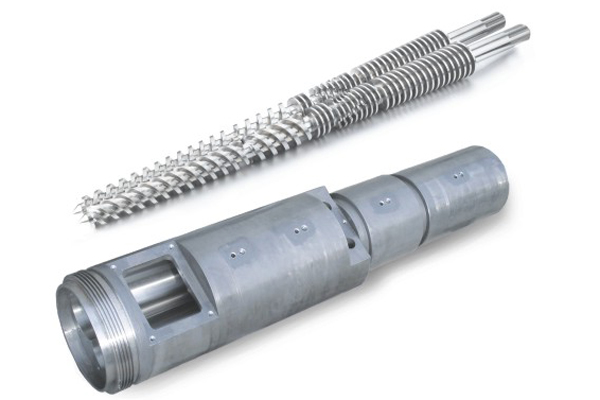Most of the wear of the conical twin screw barrel occurs in the high pressure area, especially in the transition section and the last few turns of the metering section. These areas are prone to wear because the high pressure will cause the conical twin barrel screw to bend, which will cause the outer diameter of the screw to contact the metal on the inner wall of the barrel, which will cause wear. The force that causes the conical twin barrel screw to bend is caused by the pressure difference, not the usual high pressure. However, the contact between the outer diameter of the screw edge and the inner wall of the barrel does occur, but this is caused by mechanical conditions and indicates potentially more serious problems: such as misalignment, gear box damage, screw bending, machine Cylinder bending and insufficient foundation, etc. According to wear tests in many industries, the increase in pressure and temperature will cause the friction of the cone and twin barrel screw to increase.

Conical twin barrel screw wear is usually a slow process, and it is not easy to be noticed before the performance is significantly reduced. Slight wear has little effect on overall performance, because the machine parameters can be adjusted to maintain productivity. When the radial gap between the spiral edge of the conical twin barrel screw and the barrel wall increases, leakage is inevitable. Operators usually observe the phenomenon of a decrease in the output and an increase in the melt temperature, and at the same time they have to increase the speed of the conical twin barrel screw to maintain the required output. This process is often accompanied by more energy. Consumption. With the increase of the radial clearance, the conical twin barrel screw cannot generate the necessary pumping pressure to maintain the expected output.
In the repair process, the conical twin barrel screw must be ground to a uniform undercut diameter, and then the screw edges must be re-welded to apply a wear-resistant surfacing alloy with higher hardness to the surface. These alloys can provide better The wear resistance. After the surface surfacing, the outer diameter of the conical twin barrel screw must be ground to the original tolerance. The remaining overhanging welds must be profile ground to ensure the smallest possible loss of thread width. In this process, some bad operations will reduce the effective thread width, which may have a potential impact on the performance of the conical twin-barrel screw and complicate the possibility of future repairs of the conical twin-barrel screw. To help alleviate these complex situations, some screw manufacturers choose to reduce the width of the welding. However, if this method is adopted, when these conical twin-barrel screws are ground to the original tolerance, the hard surface welding material will not cover the entire width of the spiral edge, which will have a negative impact on the wear resistance of the conical twin-barrel screws. Because there will be a softer substrate exposed to the outside.

 E-mail :
E-mail :  Tel : +86-574-55002386
Tel : +86-574-55002386
 Fax : +86-574-86365887
Fax : +86-574-86365887
 Add : No.158, Qiancheng Rd, Zhenhai, Ningbo City Zhejiang Province, China
Add : No.158, Qiancheng Rd, Zhenhai, Ningbo City Zhejiang Province, China 